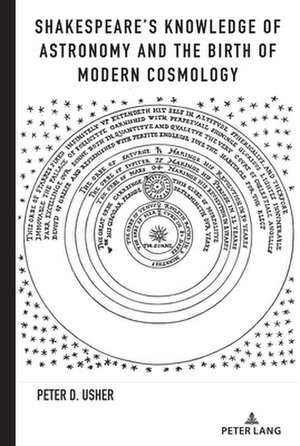Shakespeare's Knowledge of Astronomy and the Birth of Modern Cosmology
Autor Peter D. Usheren Limba Engleză Hardback – 29 noi 2021
Hamlet and other plays by Shakespeare are allegories for the major theories of cosmology extant during the poet's lifetime. Shakespeare writes of the competition between Earth-centered and Sun-centered cosmologies, and between planetary systems in bounded and infinite space. Prior to 1609-1610 when telescopic observations of celestial objects were supposedly first made, Shakespeare describes properties of celestial objects that can be seen only with telescopic aid. In 1576, Thomas Digges presented a now-famous diagram depicting the essence of a solar system and an infinite universe of stars, and we argue that it is based on telescopic observations. It is a representation of contemporary empirical knowledge which together with an infinite universe model that Giordano Bruno proposed in 1584, may be regarded as the beginning of modern cosmological science. Allegorical interpretation of plays in the canon features the astronomical work of Claudius Ptolemy, Nicholas Copernicus, Tycho Brahe, Thomas Harriot, and Galileo Galilei. The celestial subtext of Hamlet in the First Folio of 1623 appears to have been censored. Thomas Digges' father Leonard studied the optics of Roger Bacon and developed a telescopic theodolite, and he is likely the source of the astronomical data. Leonard is reported to have died over a span of twenty-three years, but his desire for anonymity can be understood from contemporary culture and events, and from his regard for Pythagoras, the first philosopher to favor an orbiting Earth. Later in life, Leonard published his data through the medium of stage plays.
Preț: 544.98 lei
Preț vechi: 707.77 lei
-23% Nou
104.29€ • 109.24$ • 86.43£
Carte tipărită la comandă
Livrare economică 08-22 aprilie
Specificații
ISBN-10: 1433191709
Pagini: 285
Dimensiuni: 1558 x 235 mm
Greutate: 0.45 kg
Editura: Peter Lang Copyright AG
